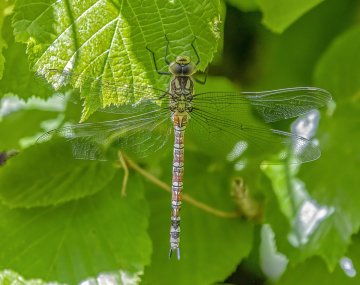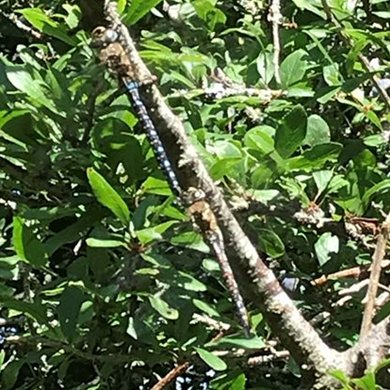Living Planet
Nature · Earth · ClimateNotes from the Field: A Dance of Dragonflies

It was a warm Saturday afternoon in mid-August (2019) and as we rounded the tree-lined bend at the bottom of the field, alongside the low stream, we paused by the bridge, as we always do, to watch the slow, gliding, silent water suddenly accelerate in a rush and roar away down the water-fall the other side. Differing shades of green from trailing ivy to bracken, swaying leaves and some rampant Himalayan Balsam were attracting butterflies on the banks and birds were singing in the trees. Turning away to begin our amble up the hill, something suddenly darted above my head and then another, and then another, each crossing from a different angle, and as we looked ahead, to our left and right and even turning behind we found ourselves in the middle of an incredible 'dance' of dragonflies!

We stood, rooted like tree trunks in the now open field as they whirled, zig-zagging, back and forth, up and down, towards us and away. We could just make out flashes of yellow and brown and occasional streaks of blue, but so, so fast, like refracting, shattered shards of light, that just seen out of the corner of one eye, suddenly vanished. Trying to count them was equally hard, I think there may have been up to about 50 but maybe more...

It appeared that everything surprising was 'upon the wing' that day. It wasn't until 24 hours later that the dragonflies began to perch in a sheltered glade, hanging their 6.5cm bodies vertically downwards to catch as much sunlight as possible. Although expertly camouflaged I was able to see them more closely and properly identify both the bluer males and the more yellow and brown females - some hanging only centimetres away from each other, with their segmented bodies, two pairs of densely veined wings and distinguishable yellow 'golf tee' or 'wine glass' at the front of the abdomen. Unlike other dragonflies they often rest near each other in pairs or small groups. Once uncommon migrants from the continent 60 years or so ago they are now continuing to spread north and westwards from south-east England. The second half of August when larger numbers tend to be seen, is when populations near the south and east coasts are augmented by immigration from the continent. (I was visiting family in East Sussex).
 Spot the dragonfly! The male Migrant Hawker in the photo is above and the female below, sharing the same branch.
Spot the dragonfly! The male Migrant Hawker in the photo is above and the female below, sharing the same branch.
It's likely that it's the rise in temperatures that's enabled this species to complete its life cycle in the UK. Those that are resident have spent most of their lives in the water as larva feeding on aquatic creatures and insects, surviving small levels of pollution but dependant on vegetation in still or slow-moving water margins where the females can lay their eggs.
Having entered a dormant state over the winter, the eggs hatch and go through different larval stages in spring and summer before the larvae climbs up out of the water for its final moult, using upright stems at the water's edge to free its new glistening wings. These newly emerged young 'tenerals' wait for their legs, bodies and wings to harden, and then begin hunting. They'll spend about a week feeding, darkening in colour and reaching sexual maturity before finding a mate and the female will lay her eggs to complete the cycle again.
It's amazing to think that Dragonflies have been around for over 300 million years, before dinosaurs and birds, when they had wingspans of 75cm, so they've had time to hone their amazing flying skills. I can attest to the Migrant Hawkers acrobatics and speed first hand - patrolling at 3m, upside down and backwards just as easily as straight ahead. No other creature seems to have its aerial dexterity and our aeroplane designers of the future could I'm sure learn a thing or two.